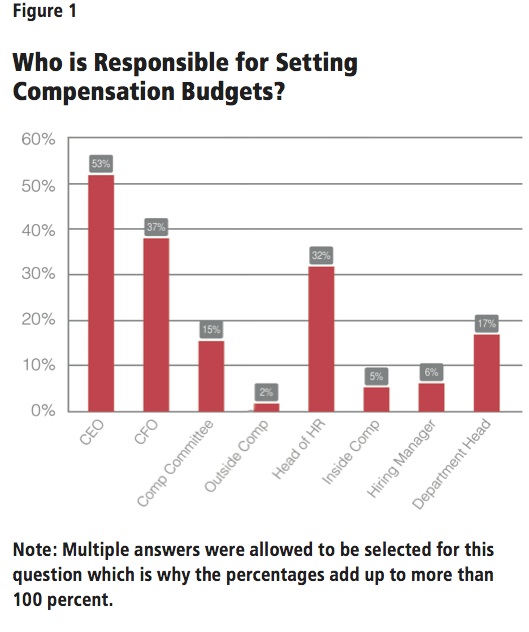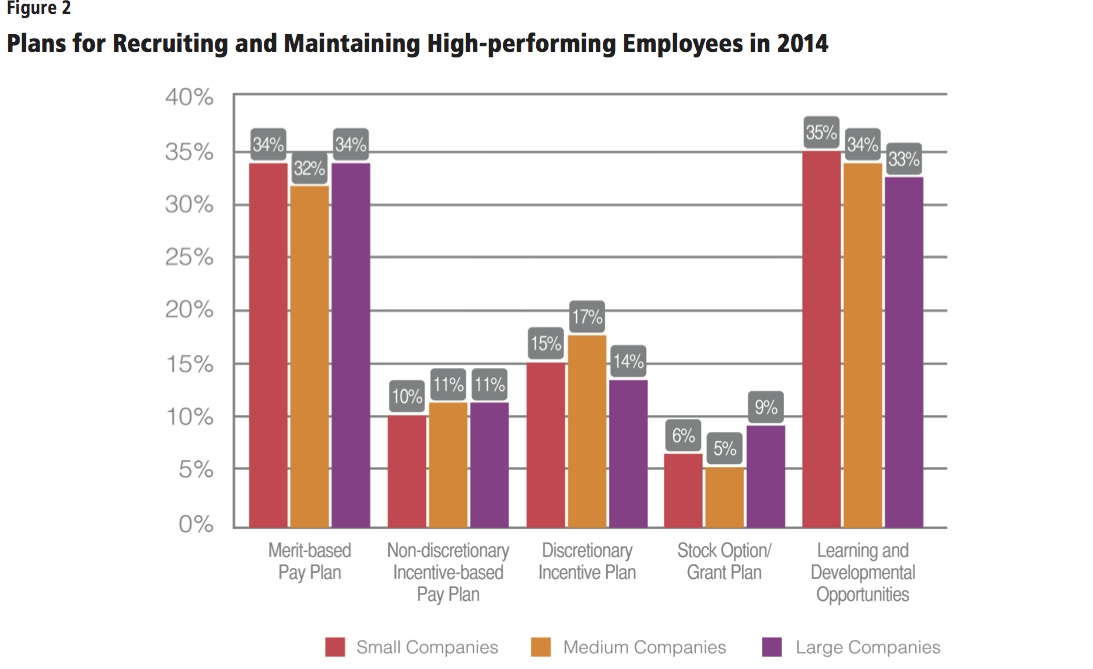
A new report reveals now is the time to leverage pay to attract and retain the right talent.
By Tim Low
PayScale’s annual survey of compensation best practices reveals more encouraging economic signs than seen in recent years as companies are growing in size and offering raises to current employees. Yet this increased optimism comes along with a good dose of caution as most companies lack sufficient business insight to know what to pay to effectively attract and retain the right people. Competition for key talent is also heating up. Growth and hiring surges are causing big concerns about retention as employees leave for greener pastures. With the more competitive economy of 2014, companies will be challenged to balance growth with smart decisions about how to compensate talent.
Organizations are cautiously optimistic about 2014, with 72 percent expecting their financial situation to improve (up from 66 percent in 2013), and only 5 percent expecting it to weaken (down from 7 percent in 2013).
Small companies are the most optimistic about their future financial performance (75 percent of respondents) beating out both large and medium companies, where
66 percent and 72 percent expect improvement in 2014. The information, media, and telecommunications industry is planning to fly the highest in 2014, with 84 percent of companies in this industry anticipating improved financial performance.
Hiring is also up over recent years with 54 percent of companies reporting plans to continue expanding in 2014. Raises returned in 2012 and that trend continued with 83 percent awarding salary increases in 2013, and 88 percent planning to give raises in 2014, with the average raise expected to be 4.5 percent. The most common reason for raises was performance-based pay increases (54 percent). Bonuses were also a popular option. In 2013, 75 percent of respondents awarded bonuses, up from 71 percent in 2012. The most common type of bonuses given were individual incentive bonuses (50 percent).

Factors and Considerations
Talent retention. Competition is heating up and it’s becoming increasingly challenging to strike the balance between paying enough to retain top talent and adhering to the compensation budget. Talent retention continues
to be the primary concern among businesses. In 2009,
only 28 percent of companies listed retention as their top concern, but by 2013 that number more than doubled, increasing to nearly 60 percent. That number jumps to 70 percent in the information, media, and telecommunications industry and 65 percent in professional, scientific, and tech services industry—two industries where tech jobs are highly represented.
Skilled talent. The skills gap also continues to be a top concern for most businesses. Half of companies surveyed cited they are struggling to fill skilled job positions with nearly two-thirds of companies in the information, media, and telecommunications industry and manufacturing companies reporting concerns.
Data accuracy. Few companies are confident in their data. Even though getting pay right is a crucial component to retention, only 26 percent of companies reported being very satisfied with the salary data they use to set compensation.
Organizational growth. Of the 52 percent of organizations that reported increasing the size of their workforce, 46 percent reported grew up to 10 percent. Medium companies are growing fastest. Medium-sized companies were the most likely to increase workforce in 2013 (58 percent), with large companies close behind (55 percent), and small companies less likely (47 percent). Information, media, and telecommunications industry leads the way with 63 percent of organizations increasing their workforce. Previous work experience is the leading factor that impacts hiring decisions (40 percent), with skill set not far behind (31 percent).
Turnover. The top two reasons for people leaving an organization in 2013 were the same as 2012 and 2011: personal reasons and seeking higher pay elsewhere (21 percent).
Relocation, retirement, and cultural fit remained stable as additional reasons for leaving an organization in 2013. Relocation remained at 5 percent, retirement likewise remained at 7 percent, and culture fit rose from 9 percent to 10 percent. For small companies, poor performance was the most important reason for someone leaving an organization (23 percent), and 56 percent of small companies said it was one of the top three reasons. For medium and large companies, seeking higher pay and advancement opportunities elsewhere were the two most common reasons.

Compensation Data
While companies are striving to secure talent, they lack sufficient insight about effective compensation to attract and retain the right people. In our 2013 survey, a whopping 75 percent of respondents reported some degree of dissatisfaction with the compensation data and insights available to them. This underscores a huge need for access to better compensation data reflecting real-time market trends.
Since 2009, the majority of respondents report the CEO as the individual responsible for setting compensation (see Figure 1). The least popular choice in all years was outside compensation consultant, with 2 percent in 2013, and 3 percent or less of the responses in 2012 and 2011. The same pattern appeared across most industries and company
sizes, except large companies, where the head of HR (48 percent) is usually responsible for setting compensation budgets, while CEOs and CFOs are second (38 percent and 39 percent respectively). Across all industries, the main reason why companies adjusted compensation was performance- based pay increases (54 percent) and second was cost of living adjustments (20 percent). The most important compensation objective guiding the respondents’ 2013 decisions was retaining top employees, which was chosen
by 66 percent of respondents (identical to 2012). This was true across all company sizes and industries.
The second most common response was attracting new talent with 11 percent of respondents choosing it as their primary objective, and 39 percent choosing it as the second most important objective.
Salary ranges per job group are common, but varying
the target market percentile per job group is not. The majority of companies (79 percent in 2013 and 82 percent in 2012) use salary ranges to structure compensation programs, while in 2012 and 2013 only 6 percent use broad banding (very wide salary ranges covering a progression of similar jobs).
Bonuses were a popular option for employers in 2013, with 75 percent of respondents saying they gave variable pay incentives. In 2012, 71 percent gave bonuses and 70 percent of respondents gave bonuses in 2011. Among those giving bonuses, the two most likely recipients were directors and managers (72 percent) and executives (67 percent). In 2013, as in 2010, 2011, and 2012, individual incentive bonuses were the most common type given, with about half of all respondents reporting they awarded them. Respondents favored spot bonuses or other discretionary bonus programs more in small and medium-sized companies (37 percent and 41 percent respectively) than in large-sized companies (35 percent).
Ensuing Optimism
Companies are optimistic about 2014, with 72 percent expecting their financial situation to improve (66 percent in 2013), and only 5 percent expecting it to weaken
(7 percent in 2013). That being said, 57 percent of companies feel employee retention is a high concern or their top concern in 2014. Organizations are focusing on offering merit-based pay and learning and development opportunities to attract and retain quality employees in 2014 (See Figure 2).
Tim Low is vice president of marketing at PayScale. The Compensation Best Practices survey was conducted in November and December of 2013 and there were 4,738 respondents among small, mid-sized, and large companies.














